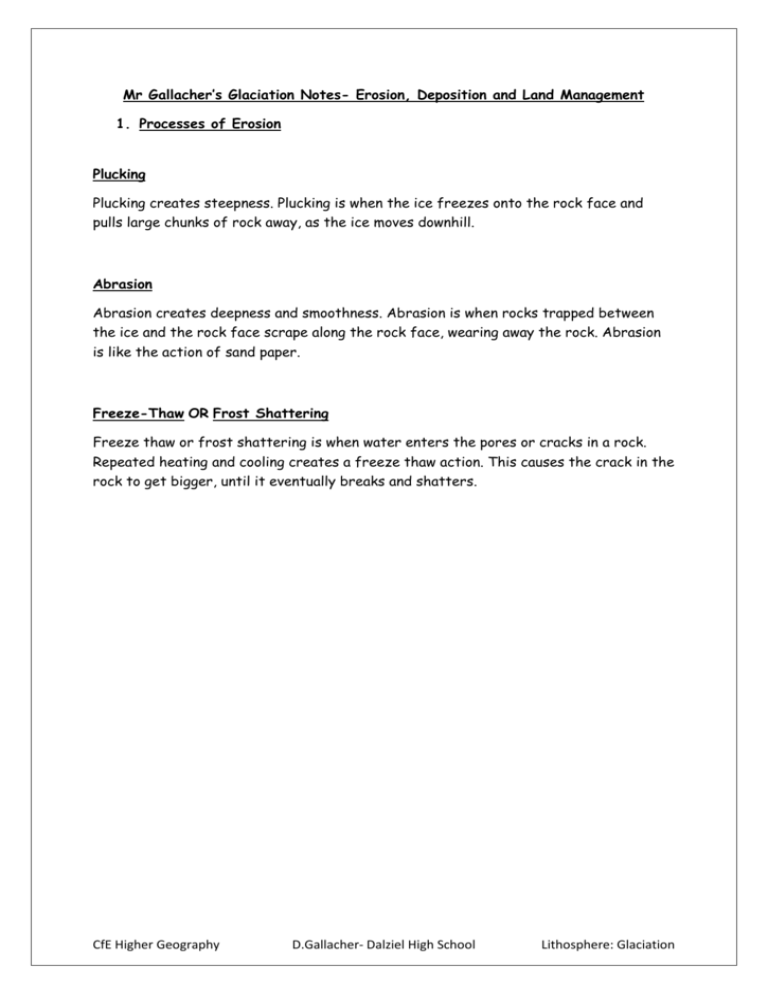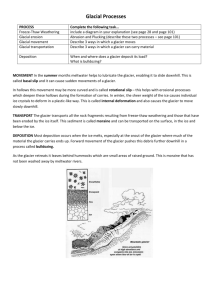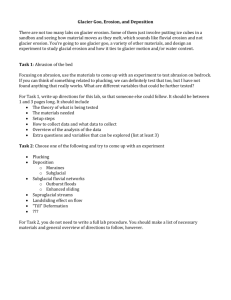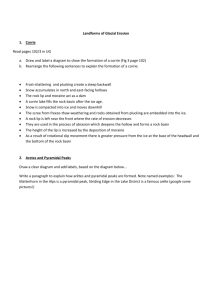5. Glaciation- All Notes MrG
advertisement

Mr Gallacher’s Glaciation Notes- Erosion, Deposition and Land Management 1. Processes of Erosion Plucking Plucking creates steepness. Plucking is when the ice freezes onto the rock face and pulls large chunks of rock away, as the ice moves downhill. Abrasion Abrasion creates deepness and smoothness. Abrasion is when rocks trapped between the ice and the rock face scrape along the rock face, wearing away the rock. Abrasion is like the action of sand paper. Freeze-Thaw OR Frost Shattering Freeze thaw or frost shattering is when water enters the pores or cracks in a rock. Repeated heating and cooling creates a freeze thaw action. This causes the crack in the rock to get bigger, until it eventually breaks and shatters. CfE Higher Geography D.Gallacher- Dalziel High School Lithosphere: Glaciation 2. Formation of a Corrie Before Glaciation 1. Temperatures: begin to drop and it starts to snow. The snow gathers in a north facing hollow. This is because the sun cannot melt it here. Neve forms: The layers of snow build up and a neve is formed as the air is squeezed out. As the air is squeezed out, the granules of snow crystalize and the snow turns to ice. It also turns blue in colour. During Glaciation 2. The ice moves downhill under the force of gravity. The glacier creates momentum because ice over 30Km thick can flow in a plastic form due to changes in its internal crystal structure. This allows the ice to change shape as it moves downhill. 3. The hollow has become much deeper, forming a nivation hollow due to the forces of plucking and abrasion. A bergschrund forms – this is a large crevasse which separates the flowing ice from the ice attached to the back wall. 4. Plucking creates a steep back wall. Plucking is when the ice freezes onto the rock face and pulls large chunks of rock away, as the ice moves downhill. Abrasion creates a deep smooth base. Abrasion is when rocks trapped between the ice and the rock face scrape along the rock face, wearing away the rock. Abrasion is like the action of sand paper. 5. Frost Shattering weathers the peak of the mountain, making it jagged. Rocks fall off and are transported by the glacier. This aids abrasion. This is when water enters the pores or cracks in a rock. Repeated heating and cooling creates a freeze thaw action. This causes the crack in the rock to get bigger, until it eventually breaks and shatters. 6. Friction causes the glacier to melt near the rock face, which lubricates the ice. This helps rotational slip to move the glacier out of the hollow. 7. As the glacier moves out of the hollow, it loses energy and starts to deposit rocks which it is carrying. These rocks build up to form the corrie lip. After Glaciation 8. Temperatures rise and it the ice/snow begins to melt. Glaciers retreat. Glacial melt water is often left in the corrie, which forms a lochan or a tarn. CfE Higher Geography D.Gallacher- Dalziel High School Lithosphere: Glaciation 3. U-Shaped Valley, Hanging Valley, Misit Stream and Scree U-Shaped Valley and hanging valleys are formed in a very similar way to the formation of corries, arêtes and pyramidal peaks. Like the corrie, it takes place over three stages. Before Glaciation 1. Temperatures: begin to drop and it starts to snow. The snow gathers in a v-shaped valley. Neve forms: The layers of snow build up and a neve is formed as the air is squeezed out. As the air is squeezed out, the granules of snow crystalize and the snow turns to ice. It also turns blue in colour. Interlocking Spurs: Interlocking spurs are present in the v-shaped valley where the river was not powerful enough to erode through hard bands of rock. During Glaciation 2. Bulldozing: The ice bulldozes through the valley making the sides steeper and the valley deeper. 3. Plucking creates steepness. Plucking is when… 4. Abrasion creates deepness. Abrasion is when… 5. The glacier rocks back and forward to create friction, which acts as a lubricant. The lubricant helps the glacier move through the valley. 6. Spurs: The glacier is so powerful that, unlike the river, it has the power to erode the interlocking spurs. When this occurs, a truncated spur is created. After Glaciation 7. Temperatures rise and the ice begins to melt. 8. Misfit Stream- where the glacial deposits build up to form moraine along the base of the u-shaped valley, often a misfit stream will form in the depression between moraines. 9. Ribbon Lake- where the glacial meltwater fills the valley often a ribbon lake is formed. 10. Scree- scree is often formed on the steep slopes of the U-shaped valley. Scree is when frost shattering attacks the cracks and weaknesses in the rock. The rock fragments are made looser when the weaknesses are further attacked by wind and rain. Scree is loose fragments of rock on the valley slopes. Hanging Valley Often in the tributary valley, a smaller glacier will form. The same processes take place, but on a much smaller scale. The tributary valley is made wider and deeper, but not as deep as the main valley. When the ice retreats CfE Higher Geography D.Gallacher- Dalziel High School Lithosphere: Glaciation 4. Glacial Deposition – Moraines, Drumlins, Erratics What is glacial deposition? Glacial deposition is when the glacier loses energy and as a result, it starts to deposit any rocks, fragments or debris it is carrying. Glacial Deposition takes place in two forms: a. Glacial Deposits- this is when the glacier drops debris that it is carrying as it retreats. Glacial deposits (often called till) are unsorted mounds and are described by geologists as unstratified. b. Fluvio-glacial deposits- these are formed by the meltwater streams which are formed as the glacier melts. The meltwater streams deposit the debris as they move downstream. These types of deposits are sorted or stratified. Terminal Moraine• This is an unsorted crescent shaped mound of rocks and debris which mark the furthest point the glacier travelled. • The snout of the glacier pushed rocks and gravels forward which remained in the same place well after the glacier melted or retreated. • If more than one glacier has been present, but not travelled as far as the original, a second form of terminal moraine is found called recessional moraine. Ground Moraine • Often called Boulder Clay or Till • Material was transported by glacier and deposited when the ice retreated. • Ground Moraine is considerably deep Lateral Moraine • Found at the side of where the glacier would have been • The debris from freeze-thaw (scree) is left behind marking out how wide the glacier was. Medial Moraine This is when two glaciers converage, as do the lateral moraines, which merge to form medial moraine. As medial moraine is two moraines together it is often thicker and deeper. CfE Higher Geography D.Gallacher- Dalziel High School Lithosphere: Glaciation Drumlins Drumlins are: Drumlins are small hills formed by glacial deposition. Drumlins are formed as a result of glacial deposits which mean that they are unsorted mounds of glacial till. Trigger: Drumlins are formed when the melting glacier stops moving due to a trigger such as a rock, or slow melting chunk of ice in the ground. The glacier begins to melt around the trigger and the materials build up to form the steep stoss of the drumlin. Stoss and Lee: The stoss is made steeper by plucking, as the glaciers erosional powers are still at work. The rest of the debris forms on the opposite side of the trigger, forming the gentle lee slope. The lee is left facing the direction that the ice moved in. Erratic Erratic are large pieces of rock which are plucked by the glacier and transported down the valley. Erratic are large pieces of rock found in low lying areas and are different to the bed rock of the area they are found. Kettle Hole A kettle hole is a depression found in the ground, filled with water. As the glacier melts, chunks of ice often melt slowly into the ground. As the fluvio-glacial streams flow around the ice, they deposit sediments. The sediments build up to form an outwash plain. The ice continues to slowly melt. Sediments then build up on top of the ice. Eventually, the sediments collapse, fall into the depression and the kettle hole is formed. If a kettle hole is deep enough to reach the water table, it forms a kettle lake. CfE Higher Geography D.Gallacher- Dalziel High School Lithosphere: Glaciation Land Use conflicts and Solutions : Glaciated Upland There are a number of land use conflicts and matching solutions which take place in glaciated upland areas like Loch Lomond and the villages which surround it. A summary of what we have studied is listed below: Conflict Tourists leave farmers gates open which allows sheep to escape. Tourists going for long walks across farmers fields can lead to footpath erosion Loch Lomond Is notorious for illegal camping and outdoor drinking which upsets farm animals and local people. House Prices increase in honeypot areas like Balloch and Luss due to the demand by tourists. Tourists also buy up these houses for holiday homes which leads to the ghost town effect. Many of the services in the area are aimed only at tourists. This means that the price of goods in shops often increase. Ghost Town Effect- in low season the honeypot tourist areas are often left with few tourists which can lead to seasonal unemployment in places like Luss Tourists cause traffic problems at peak times like bank holidays and weekends. They cause congestion on the narrow A82 road, CfE Higher Geography Solution Step Stool fences or kissing gates which mean the gates close automatically meaning sheep stay in the field Wooden planks or boards can be put down on popular routes which save people walking on the grass. Often, some footpaths are closed and people are directed to other ones which allow the old ones to regenerate. Park Rangers are employed to educate people about the countryside code and respecting the area. National Park Police have the power to disperse people which stops them from drinking outside Camping is illegal in Loch Lomond, unless it is in a designated approved camping area. Local bylaws in some villages/areas often stop people from buying up local properties unless they are born in the area or have rented for a period of time. Help to buy schemes introduced by the recent government have offered a 20% equity loan to help people onto the property ladder. IN some areas, there is a postbus which delivers mail but also picks up local people and takes them around the area. Large super markets are often given incentives to develop in or around these areas to bring down the price of commodities. At loch Lomond, more activities have been introduced in low season. For example, there is now a drive in movie theatre at Halloween and Christmas. Out of town car parks on the outskirts of villages stops cars from entering the village making it less congested. There are extensive car parking facilities south of Loch Lomond at Loch Lomond Shores. D.Gallacher- Dalziel High School Lithosphere: Glaciation around villages like Luss and often park on grassy verges if there are no other parking spaces available. HEP stations are deemed as an eyesore due the industrial looking pipes. They are also noisy during construction which detracts from the peacefulness of the area, sought by tourists. CfE Higher Geography Sustainable transport links have been developed between Glasgow and Loch Lomond. There are regular bus services and direct trains to Balloch Train Stations. Often, trees are planted around the pipes of the HEP station which disguises the industrial looking pipes. To minimise noise pollution, the HEP Stations are built in low season when there are less tourists about. D.Gallacher- Dalziel High School Lithosphere: Glaciation








